On Starfleet starships, Jefferies tubes are internal maintenance conduits that are used to provide crew access to various ship's systems. In emergencies they're also used for moving around the ship if turbolifts are not functional. Doors within the Jefferies tubes can be sealed for safety or security reasons. It should be noted that on all ship displays of internal structure Jefferies Tubes are not displayed, and in some cases show no sign where they could actually fit within the ship. During the 22nd and 23rd century, Jefferies tubes were usually referred to access tubes or access tunnels. It wasn't until the 24th century that their official name was firmly established.
Jefferies tubes can also be used for fitness training exercises. (VOY: "Learning Curve")
Geordi La Forge sarcastically remarked about Starfleet engineers claiming Jefferies tubes being "easy access." (TNG: "Power Play")
22nd Century

The entrance of a Jefferies tube aboard an NX class starship.
During the 22nd Century, starships were outfitted with long and small service tunnels what would later be known as Jefferies tubes.
They were hard, cold, cramped and poorly lit. There were absolutely no junctions, so a crewmen would have to take many different tubes to get to his or her destination. Truly the Jefferies tube was in its infancy.
Vertical Tubes

A vertical tube (2150s).
The NX ships had vertical tubes to help their crew manually reach decks above them or below them. These tubes were circular from one end to the other. Each tube was equipped with a single one-way ladder for crewmen to climb or descend. The ladders had dim lights behind them so the crew could see where to step.
Horizontal Tubes

A horizontal tube (2150s).
The horizontal tunnels were not very different from the vertical ones. They were also circular and narrow. Crewmen had to bend their knees and crouch down at a bent posture while walking inside these specific tubes. A majority of the tube's space was filled with long and thick engineering pipes that went from one end to the other. These tubes were lit from the floor so a person could follow a path.
23rd Century
The inside of a Jefferies tube aboard a Template:ShipClass starship.
In the 23rd Century, Jefferies Tubes were still in their infancy. The tubes were still round and small, but this time they were better lit and weren't just a means to get around. They served many different functions and purposes. It was not uncommon to find many technicians and engineers tinkering inside them.
Diagonal Tubes
The entrance to a Jefferies tube.
Many diagonal tubes were scattered all throughout starships. These tubes were always densely connected with important system controls, relays, various conduits and vital engineering circuits. Some of these tubes led to crawlway junctions, while some even continued on inside a nacelle pylon to one of the ship's actual Warp Nacelle. At the entrance of each tube were two red bars so a crewmen could pull him or herself inside. A soft, yet strong light was always emitted from the top and filled the entire tube. Certain tubes had multiple functions, while others had single functions like the tubes which were only designated Engineering Circuit Bays. Each diagonal tube was equipped with stairs for crewmen to walk up or down. (TOS: "Charlie X", "The Doomsday Machine", "Journey to Babel") (ENT: "In a Mirror, Darkly, Part II")
Vertical Tubes
A vertical Jefferies tube (2260s).
The vertical tubes on a starship, also known as gangways, allowed manual access to decks both above and below. These particular tubes were easily accessible in the open hallway alcoves located on every deck. On the walls of these tubes there was a reflective material that perfectly illuminated the entire tunnel. The tubes were equipped with a single three-way ladder to allow more than one crewmen to climb or descend. (TOS: "Amok Time")
Horizontal Tubes
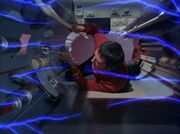
A horizontal Jefferies tube (2260s).
A horizontal Jefferies tube aboard a refit Constitution class starship (2280s).
The horizontal crawlways on starships allowed manual access to various parts of a starship. These tubes were also densely connected with important system controls and vital engineering circuits. Some of these tubes even led to the Matter-Antimatter Reaction Chamber. Every few feet, a bright light could be found shining down. Crewmen usually had to crawl while traveling in some of them due to the cramped size. Other horizontal tubes were still cramped, but crewmen could still walk freely up straight in posture. This was especially true late in the 23rd Century. Late in the 23rd Century, the horizontal tubes were extremely well lit with lights coming from both above and below. (TOS: "That Which Survives") (Star Trek V: The Final Frontier)
Tube Junctions
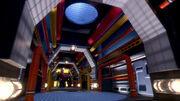
Jefferies tube junction crawlway (2260s).
On a starship, the Jefferies tubes had junction service crawlways. They served as interconnected points linking all the different tubes. On Template:ShipClass vessels, these junctions also gave access to critical starship systems like
plasma flow regulators, warp and power relays. (ENT: "In a Mirror, Darkly, Part II")
24th Century

The inside of a Jefferies tube aboard a Sovereign class starship.
During the 24th Century, Jefferies Tubes became more simple, less intricate and not as meticulously crammed with vital systems.
Vertical Tubes
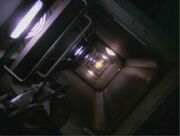
A standard 24th Century vertical tube aboard a starship (2370s).
The vertical tubes on starships allowed manual access to decks both above and below, which were labeled inside these particular tubes. Dim lights were located behind the main ladder and other lights were found on every deck. These tubes were equipped with a single one-way ladder for crewmen to climb or descend.
Horizontal Tubes
A standard 24th Century horizontal tube aboard a starship (2370s).
The horizontal crawlways on starships allowed manual access to various vital parts of a ship or station. Dim lights were located near the floor and on each side of the tube. Crewmen usually had to crawl while traveling in them due to the cramped size. Inside these tubes were removable panels to important system conduits and engineering controls.
Tube Junctions
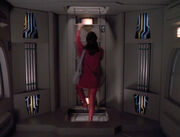
A 24th Century tube junction (2370s).
On 24th Century starships, all Jefferies tubes had junction service rooms. They served as interconnected points linking all the different tubes. Every room had exposed conduits on the walls, sometimes with panels to access various power conduits or relays.
According to Nella Daren, the fourth intersect of Jefferies tube twenty-five was the most acoustically perfect spot on the USS Enterprise-D. (TNG: "Lessons")
Appendices
Appearances
- Appearances
- TOS:
- TNG:
- "The Hunted"
- "Brothers"
- "Galaxy's Child"
- "The Nth Degree"
- "Disaster"
- "The Game"
- "Power Play"
- "Cost of Living"
- "Realm of Fear"
- "Rascals"
- "The Quality of Life"
- "Chain of Command, Part I"
- "Starship Mine"
- "Lessons"
- "Timescape"
- "Interface"
- "Force of Nature"
- "Eye of the Beholder"
- "Genesis"
- "Emergence"
- DS9:
- VOY:
- "Emanations"
- "Learning Curve"
- "Twisted"
- "Deadlock"
- "Macrocosm"
- "Fair Trade"
- "Before and After"
- "Displaced"
- "Worst Case Scenario"
- "Scorpion"
- "The Gift"
- "Revulsion"
- "Scientific Method"
- "Year of Hell"
- "Waking Moments"
- "Prey"
- "The Killing Game, Part II"
- "One"
- "Timeless"
- "Counterpoint"
- "Course: Oblivion"
- "Someone to Watch Over Me"
- "Relativity"
- "Warhead"
- "Alice"
- "The Voyager Conspiracy"
- "Pathfinder"
- "Blink of an Eye"
- "Memorial"
- "Collective"
- "The Haunting of Deck Twelve"
- "Repression"
- "Nightingale"
- "Q2"
- "Renaissance Man"
- ENT:
- Mentions
Background Information
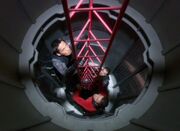
The remarkably innovative three-way ladder was never seen again.
The Jefferies tubes were named in honor of Matt Jefferies, the designer of the original Enterprise and the Production Designer of Star Trek: The Original Series who later became the Art Director. The name was originally an in-joke, but came to be mentioned frequently in The Next Generation. The access tubes have changed appearance many times in the past 40 years, while still maintaining their basic function for both the series and films. The tubes were commonly used as a last minute deus ex machina, whether it was a relay circuit inside that needed to be repaired, or a straightforward means of physical escape.
The most unique variation of the Jefferies tube was a vertical tube shown in the original Star Trek series. This access tube had a "three-way" ladder that allowed three separate people to climb simultaneously. This was no doubt convenient during red alert when crewmen needed to get to battle stations quickly. Unfortunately this concept was never expanded upon, so we never saw a four, or even a six sided hexagon-shaped ladder. Instead, the Jefferies tubes ladders in the 24th century were only capable of supporting one individual.
GNDN #435
An in-joke reportedly appearing in the Jefferies tube sets on the original Star Trek series (although written so small as to be invisible to the audience) are labels on the pipes marked "GNDN". This stands for "Goes Nowhere, Does Nothing." The marking also appeared on various sets for the Star Trek films.
